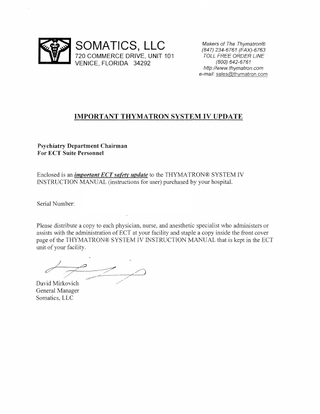Somatics
THYMATRON SYSTEM IV Addendum
Addendum
3 Pages

Preview
Page 1
Makers of The Thymatron® (847) 234-6761 (FAX)-6763 TOLL FREE ORDER LINE
(800) 642-6761 http://www.thymatron.com e-mail: sales@thymatron.com
IMPORTANT
THYMATRON
SYSTEM IV UPDATE
Psychiatry Department Chairman For ECT Suite Personnel
Enclosed is an important ECT safety update to the THYMA TRON® SYSTEM IV INSTRUCTION MANUAL (instructions for user) purchased by your hospital.
Serial Number:
Please distribute a copy to each physician, nurse, and anesthetic specialist who administers or assists with the administration of ECT at your facility and staple a copy inside the front cover page of the THYMATRON® SYSTEM IV INSTRUCTION MANUAL that is kept in the ECT unit of your facility.
David Mirkovich General Manager Somatics, LLC
./
./
Addendum for Thymatron System IV Manual ECT requires a staff of licensed, trained and experienced professionals thoroughly familiar with current literature conceming risks, complications and methods. This literature includes ECT textbooks, journal publications, and the latest American Psychiatric Association EeT Task Force Report. Techniques in Chapters 6-11 of the 2001 edition should be followed. This Task Force Report states: "A small minority of patients treated with EeT later report devastating cognitive consequences. Patients may indicate that they have dense amnesia extending far back into the past for events of personal significance or that broad areas of cognitive function are so impaired that the patients are no longer able to engage in former occupations ... self-reports of profound ECT-induced deficits may reflect objective loss of function .. .In rare cases, ECT may result in a dense and persistent retrograde amnesia extending to years before the treatment..." ADVERSE EVENTS may occur and patients and their families must be informed of the risks and confirm their understanding in writing. Most common are headache, muscle soreness, jaw pain, other mild to moderate discomfort, nausea, disorientation, and memory dysfunction. Other possibilities include arrhythmia, cardiac complications including ischemia, infarction, hypertension, hypotension; stroke; cognition and memory impairment; brain injury; dental/oral injury; motor dysfunction; physical injury (if movements are not adequately limited); mania; delirium; agitation; neurological symptoms (e.g., paresthesias, dyskinesias); tardive seizures; prolonged seizures; non-convulsive status epilepticus; pulmonary complications (e.g., aspiration, pneumonia, hypoxia, laryngospasm, pulmonary embolism, prolonged apnea); visual disturbance; hearing disturbance; onset or exacerbation of psychiatric symptoms including depression or anxiety; disinhibition; suicidality; homicidality; substance abuse; coma; falls; skin bums and abrasions; and excessive effect or allergic reactions from anesthetic medication. Device malfunction is possible, with excessive electrical dose and higher risks of adverse events listed above. Death is reported as 1 per 10,000 patients and 1 per 80,000 treatments. Adverse cognitive effects occur in varying types and severity, and can be higher with bilateral ECT, high electrical dosage, closeJy spaced treatments, more treatments, concurrent medications, and high anesthetic doses. ECT may produce anterograde amnesia or retrograde amnesia for recent or remote memory. Memory disturbance typically dissipates over time. Permanent memory loss or brain inj ury is rare but possible. It can sometimes be impossible to identify specific causes of memory or other cognitive disturbance in patients who receive ECT. No claim is made that confusion, cognitive impairment, memory loss, structural brain change, temporary or even permanent brain injury cannot occur from ECT or the anesthesia given with ECT. WARNING: Some conditions incur markedly increased risk from EeT, e.g., cardiac illness, unstable cardiovascular function, aneurysm, cerebral hypertension, recent stroke, severe COPD or other lung impairment, pneumonia, brain injury, complications with previous anesthesia or EeT, anesthesia risk level ASA 4 or 5. Concurrent antipsychotic medication increases risks of adverse cardiac, pulmonary, and neurological
events, including falls and pneumonia. Concurrent stimulant medication and neurological risks, prolonged seizure" confusion . amnesia.
increases cardiac
outcome depends on factors outside the e.g., physical, psychiatric and emotional condition of the patient before EfT EeTtreatment details, a user and pre-existing conditions including brain injury. brain atrophy, and care was used rn the design
this 1 ~ _.
~
~
11
_
J. •
_ ,
uevice (is well as paueru
1 _ J
1
t euueu _
I"')
1
I •
•
IdCLUIS SLlCH as uiagnosrs,
1 •
meuicai
1
1 • , •
1
concnuons, ann
the influence results oftreatment llsing this device Somatics, LLC disclaims responsibility Tor matters beyond its influence and for any medical complications directly or indirectly resulting from use of this product. Except as expresslj provided by law, LLC IS NOT RESPONSIBLE FOR ANY DIRECT, INCIDENTAL OR CONSEQUENTIAL DAMAGES BASED ON ANY DEFECT, FAILURE OR MALfUNCTION OF ITS PRODUCTS WHETHER THE CLAIM 1S BASED ON WARRANTY, CONTRACT, TORT OR OTHERWISE. THIS WARRANTY IS IN LIEU OF AND EXCLUDES ALL OTHER WARRANT[ES NOT EXPRESSLY SET FORTH HLREIN. AND SOMATICS. LLC MAKES NO WARRANTY-EXPRESS OR IMPLIED-INCLUDING BUT LIMITED TO iNY IMPLIED WARRANTY OF !vlERCHANTABlUTY OR FITNESS FOR A PARTiCULAR PURPOSE OR NON-D)FRINGEMENT OR COMPLIANCE WITH ANY FEDERAL, STATE OR LOCAL LAW, RULE OR REGULATION. SOMATICS, LLC EXPRESSLY DISCLAIMS TO THE FULLEST EXTENT ALLOWED BY LAW, RULE OR REGULATION ANY WARRANTY PROVIDED UNDER ANY LAW. Copyright~ 1999:2000: 2001:2002:2003:2004:2005: 2006: 2009:2013:2015:2016: 2018 Somatics LLC. /11 rights reserved. No portion of [his manual may be reproduced by any means without permission Somatics LLC. Telephone: (800) 642 . 676l or (847) 234-6761. Fax: (847) 234 " 6763 E-flIai I: :,al~',((? lhvmalI<211~~DJ